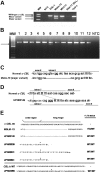Novel c-CBL and CBL-b ubiquitin ligase mutations in human acute myeloid leukemia
- PMID: 17475912
- PMCID: PMC1924768
- DOI: 10.1182/blood-2006-12-061176
Novel c-CBL and CBL-b ubiquitin ligase mutations in human acute myeloid leukemia
Abstract
The CBL ubiquitin ligase targets a variety of activated tyrosine kinases (TKs) for degradation. Many TKs are mutationally or autocrine activated and/or often overexpressed at the mRNA and protein levels in acute leukemias. We hypothesized that CBL is mutated in patients with acute myeloid leukemia (AML). Four of 12 patients and the MOLM-13 cell line harbored c-CBL mutations, either RNA splicing mutations, missense mutations, or a nucleotide insertion. Additionally, 1 of the 12 patients harbored a missense mutation in the related CBL-b gene. Each c-CBL mutation involves the structurally important alpha-helix within the linker region, while the mutation in CBL-b was located in the Ub-E2 protein-binding RING finger. Short-interfering RNA knockdown of mutant c-CBL present in MOLM-13 cells was growth inhibitory. In summary, novel mutations in c-CBL and CBL-b have been identified in human AML and may represent potential targets for novel therapeutics.
Figures


Similar articles
-
CBL family E3 ubiquitin ligases control JAK2 ubiquitination and stability in hematopoietic stem cells and myeloid malignancies.Genes Dev. 2017 May 15;31(10):1007-1023. doi: 10.1101/gad.297135.117. Epub 2017 Jun 13. Genes Dev. 2017. PMID: 28611190 Free PMC article.
-
CBL exon 8/9 mutants activate the FLT3 pathway and cluster in core binding factor/11q deletion acute myeloid leukemia/myelodysplastic syndrome subtypes.Clin Cancer Res. 2009 Apr 1;15(7):2238-47. doi: 10.1158/1078-0432.CCR-08-1325. Epub 2009 Mar 10. Clin Cancer Res. 2009. PMID: 19276253
-
Novel oncogenic mutations of CBL in human acute myeloid leukemia that activate growth and survival pathways depend on increased metabolism.J Biol Chem. 2010 Oct 15;285(42):32596-605. doi: 10.1074/jbc.M110.106161. Epub 2010 Jul 9. J Biol Chem. 2010. PMID: 20622007 Free PMC article.
-
Mutations of the TET2 and CBL genes: novel molecular markers in myeloid malignancies.Ann Hematol. 2010 Jul;89(7):643-52. doi: 10.1007/s00277-010-0920-6. Epub 2010 Mar 2. Ann Hematol. 2010. PMID: 20195608 Review.
-
Deregulated intracellular signaling by mutated c-CBL in myeloid neoplasms.Clin Cancer Res. 2010 Aug 1;16(15):3825-31. doi: 10.1158/1078-0432.CCR-09-2341. Epub 2010 Jun 14. Clin Cancer Res. 2010. PMID: 20547695 Review.
Cited by
-
A novel CBL-Bflox/flox mouse model allows tissue-selective fully conditional CBL/CBL-B double-knockout: CD4-Cre mediated CBL/CBL-B deletion occurs in both T-cells and hematopoietic stem cells.Oncotarget. 2016 Aug 9;7(32):51107-51123. doi: 10.18632/oncotarget.9812. Oncotarget. 2016. PMID: 27276677 Free PMC article.
-
Rs4911154 of circ-ITCH aggravated tumor malignancy of thyroid nodules via the circ-ITCH/miR-22-3p/CBL axis.Sci Rep. 2021 Sep 16;11(1):18491. doi: 10.1038/s41598-021-97471-5. Sci Rep. 2021. PMID: 34531437 Free PMC article.
-
CBL family E3 ubiquitin ligases control JAK2 ubiquitination and stability in hematopoietic stem cells and myeloid malignancies.Genes Dev. 2017 May 15;31(10):1007-1023. doi: 10.1101/gad.297135.117. Epub 2017 Jun 13. Genes Dev. 2017. PMID: 28611190 Free PMC article.
-
Rapid development of acute monocytic leukemia (AML-M5b) with t(9;11)(p22;q23) after chemotherapy for T-cell lymphoblastic lymphoma: A case report.Heliyon. 2025 Feb 9;11(4):e42537. doi: 10.1016/j.heliyon.2025.e42537. eCollection 2025 Feb 28. Heliyon. 2025. PMID: 40040976 Free PMC article.
-
Gain-of-function c-CBL mutations associated with uniparental disomy of 11q in myeloid neoplasms.Cell Cycle. 2010 Mar 15;9(6):1051-6. doi: 10.4161/cc.9.6.11034. Epub 2010 Mar 15. Cell Cycle. 2010. PMID: 20237427 Free PMC article. Review.
References
-
- Ryan PE, Davies GC, Nau MM, Lipkowitz S. Regulating the regulator: negative regulation of Cbl ubiquitin ligases. Trends Biochem Sci. 2006;31:79–88. - PubMed
-
- Smit L, Borst J. The Cbl family of signal transduction molecules. Crit Rev Oncogen. 1997;8:359–379. - PubMed
-
- Liu YC, Altman A. Cbl: complex formation and functional implications. Cell Signal. 1998;10:377–385. - PubMed
Publication types
MeSH terms
Substances
Grants and funding
LinkOut - more resources
Full Text Sources
Other Literature Sources
Medical
Molecular Biology Databases
Miscellaneous

